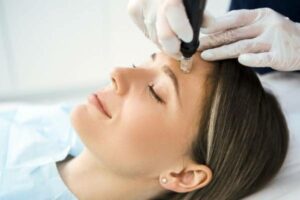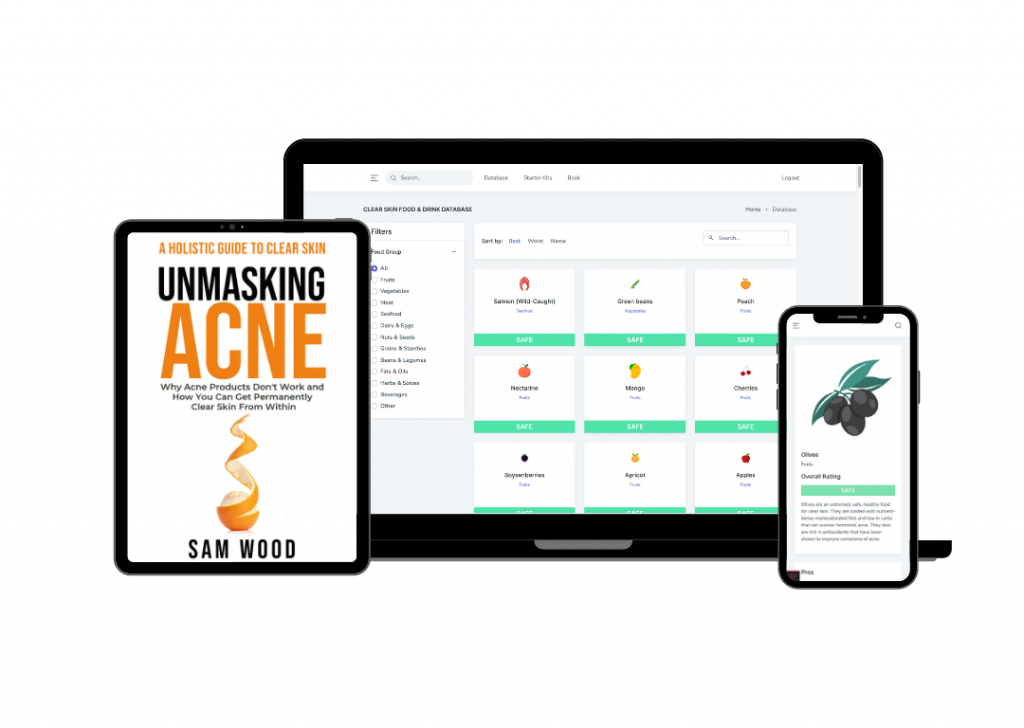Microneedling is a procedure where the skin is microscopically pierced thousands of times over a very short period of time. These tiny holes are essentially ‘micro-wounds’ which cause a reaction from the body to trigger the natural healing process. This process has many beneficial impacts on skin health, such as new collagen and elastic synthesis, as well as new blood vessels within the dermis. However, your skin can appear unsightly immediately after the procedure.
Microneedling is a fairly common aesthetic procedure nowadays, with most offices that offer botox, facial peels, or dermaplaning also offering microneedling. It is popular due to its wide range of uses such as anti-ageing (by diminishing wrinkles and fine lines) and reducing the impact of acne (by helping to reduce scarring texture.)
So, what actually happens at a microneedling appointment? First, your skin will be cleansed and if appropriate, numbed. This is usually done using a cream, which helps to reduce any pain felt during the procedure. The microneedling device is then passed across the skin, in the affected areas. Once all areas are treated, your face is cleansed again.
Common Misconceptions of Microneedling
Microneedling is painful – as the needles are very small, they can barely be felt! However, if you are sensitive to pain, a numbing cream before the procedure is a common choice.
Needles? Won’t that cause bleeding? – microneedling rarely causes bleeding, it’s unlikely to happen with shallow microneedling, whereas deeper microneedling it is more likely to occur. Even if this does occur, it’s often a small amount and well managed by the practitioner. It’s important to note this may not be a suitable treatment if you are on blood thinning medication, so always disclose this information.
Won’t the punctures cause scarring, or discoloration? – For any sort of scarring or discoloration to occur, the dermis must be damaged. This is the deepest level of the skin, meaning it won’t be touched by the needle machine used! This means it will only work on previous scarring, without creating any new ones.
Microneedling will give me an infection – microneedling has very low risks for infection, especially as the needles are sterilized before treatment, and the skin is cleansed.
Common Side Effects of Microneedling
As with any procedure there are multiple side effects, with some of the most common outlined below:
Sun sensitivity
This happens because the top layer of the skin has been damaged, meaning there are thousands of tiny holes. This means the sun’s impact is greater than usual, so protecting your skin is even more important! For the first few days after the procedure, sun exposure should be completely avoided – so grab your duvet, and cozy clothes so you can binge watch the latest programme indoors! After this initial period, repeated application of sunscreen is important.
Redness or swelling of skin
Microneedling causes a low level of inflammation, meaning swelling and redness is quite a common side effect of microneedling. This will naturally decrease with time. However, if it doesn’t decrease it’s important to get your local health provider to check out all causes, as rarely microneedling can lead to rosacea or granulomatous dermatoses (which often look like small lumps on the skin) – occurring when an underlying infection inflames tissues.
Breaking out, aka active breakouts occuring
This is much more likely to happen if you already have acne-prone skin, or already active breakouts. This is because bacteria associated with acne will get in contact with the microneedle, and the needle will then push the bacteria further into the skin. This then causes more pimples, and often more severe inflammation. This means it’s kind of counterintuitive if you are treating your acne scars with microneedling before your acne is completely inactive – you’ll just end up creating more acne, and more scars!
Skin looks worse – fine lines and wrinkles look more pronounced
In your skin there is a chemical molecule called fibronectin, which acts as scaffolding for the new collagen to grow onto. Over time the collagen will mature, and be converted into a more tightened-up version. This version makes the wrinkles and scarring look reduced. By puncturing the skin hundreds of times with the microneedling device, the collagen fibers will be ripped, and then will take time to reform. That’s why in the short term wrinkles may appear worse off!
Another factor that impacts this is an increase in a process known as TransEpidermal Water Loss (TEWL) which essentially is the loss of water from the skin. More TEWL means the skin is more dehydrated, and skin will always show fine lines and texture more when dehydrated.
Microneedling vs. Chemical Peel
Both of these treatments are touted as being some of the best for acne-prone skin (Especially with scars) as well as for diminishing fine lines. However, if you’re unsure which to choose, hopefully this short guide will help you choose! If you really aren’t sure though, ring up your local esthetician and they’ll give you some advice – they truly are the professionals!
Chemical peels, when performed by an esthetician or dermatologist will be formulated with a higher percentage of acids than you would find in a serum you can use at home. The higher the percentage of acids, the deeper down the skin layers it can usually penetrate. This means deeper rooted scars, wrinkles and severe acne nodules can be treated in this way. Chemical peels contain many acids you are likely to have heard about, they’re listed below with their impact:
- Glycolic acid : The smallest molecular size, meaning it penetrates the skin deeply. It is powerful, and treats fine lines, texture and hyperpigmentation well.
- Lactic acid : A medium molecular size, it doesn’t irritate the skin as much as glycolic acid. It doesn’t have as impressive results as glycolic acid, but it is often used alongside glycolic acid within peels
- Mandelic acid : A medium molecular size, similar to lactic acid. It is great at treating redness and pigmentation.
- Salicylic acid : The key acid used for acne-prone or oily skin types.
Your individual skin health will be assessed, so the chemical peel depth can be chosen correctly; there are usually three depths to choose from; superficial, medium or deep. The deeper the peel the greater the pain (local anesthetic, similar to the one used for microneedling is used) downtime, but also the impact is greater.
These two methods to improve skin health act in fundamentally different ways – whilst the microneedling causes low level damage to the skin, to encourage it to heal itself and thus produce new collagen to plump up any atrophic scars, the chemical peel causes the top layers of the skin to slough off (taking hyperpigmentation and congestion with it) and reveal healthier, more even-toned skin.
Any in-office treatment, performed by an accredited professional is likely to have a high price tag, which whilst warranted (do your research – don’t just trust your skin health with anyone!) may not suit everyone’s financial situation. Turning to at-home treatments may be more appropriate, and we have reviewed our favorite peels for acne scarring here.
Skincare Products to Avoid After Microneedling
Different organizations will state slightly different post-micro needling regiments, in terms of the skincare you should and shouldn’t use. As previously mentioned, the sun should be avoided entirely for at least the first 2-3 days, and then adequate sunscreen should be applied everyday from this point. It’s especially important, as your skin is extra sensitive to the sun, meaning damage is much more likely to occur (even if its cloudy).
Due to this sensitivity, any active ingredients in your usual skincare routine should be paused, so any acid exfoliants, retinols, prescription-only treatments, and vitamin C should be shelved for at least 3 days (but I personally would avoid for at least a week!)
A post-treatment routine is likely to consist of three things; gentle cleanser, (focus on hydrating and ceramides) an antibiotic cream and a very basic moisturizer/balm.
Although not skincare, it’s important to also avoid applying any makeup to the skin for a few days after the procedure. This is because any makeup will clog pores, and the micro-wounds created – which will trigger congestion and pimples. Also, most people’s makeup brushes and sponges aren’t fully clean, meaning there is old makeup and bacteria thriving on them – gross, but true. So by applying makeup to the skin, via dirty makeup tools, puts all the bacteria and grime onto the skin and can cause infections.
In general, makeup is not great for your skin. While it is not feasible for everyone to go completely “cold-turkey” long-term you should try your best to limit the amount of makeup you wear, and remove makeup as soon as your event is over.
How to Improve Skin If It Looks Worse After Microneedling
Most of the time, when skin looks worse after microneedling, it is just a short-term reaction to the procedure, and being patient really does wonders! Don’t be tempted by some of your usual skincare products, which help smooth or plump skin. Let the procedure work, and trust in the science of your skin repairing. Make sure to keep hydrated (especially as TEWL increases post-procedure) and limit intake of caffeine and alcohol, as they dehydrate both the body and skin. The eBook has some brilliant information about nutrition which may help.
Frequently Asked Questions
This is a very hard question, as everybody’s skin reacts differently to all procedures and skincare. Purging normally happens fairly soon after the procedure (2-4 days after), and if it doesn’t stop within 2 weeks, I would contact the esthetician or dermatologist who performed the procedure.
This also hugely varies! Most people will have their skin return to normal within a week, the first 2-3 days are usually the most ‘abnormal’ with the skin redness, tightness, and sensitivity occurring.

